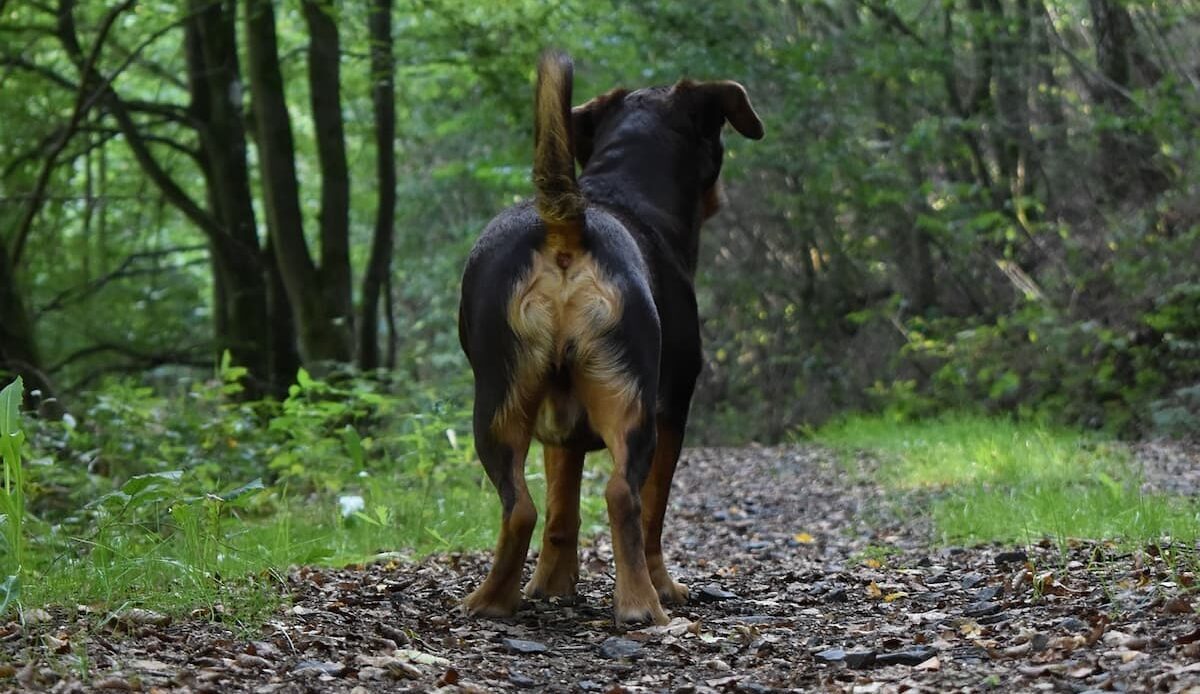Have you ever noticed your furry friend sliding their posterior along the floor like it’s the latest canine dance move?
Trust me, it’s not a quirky trick they’ve picked up at doggy school!
While it may seem amusing or puzzling at first, there are actually some fascinating reasons behind this peculiar behavior, as this article will reveal.
Symptoms and Causes of Dogs Dragging Their Butts on the Floor
When it comes to our furry companions, it’s not uncommon to see them engaging in some rather strange behaviors.
One such behavior that often perplexes dog owners is the classic butt dragging on the floor.
It’s a sight that can be both amusing and concerning, leaving us wondering why on earth our beloved pooches feel the need to participate in this peculiar activity.
Well, this behavior, known as “scooting,” can be a sign that something is off with your pup.
Dogs may drag their butts on the floor as a means to alleviate an incessant itchiness in the anal region.
This itchiness can be caused by a variety of factors, including allergies, parasites, or anal gland issues.
By scooting their behinds on the ground, they attempt to relieve the discomfort and scratch that unreachable itch.
Not the most graceful way to go about it, but hey, desperate times call for desperate measures!
Here are a few common symptoms to be on the lookout for:
-
- Scooting: The act of sliding their bottom along the floor or grass.
- Itching and Redness: Excessive scratching around the tail region, often accompanied by redness and irritation.
- Odor: A strong, unpleasant smell coming from your dog’s rear end.
- Licking: Increased licking or biting of their backside.
Now that we’ve identified the symptoms, let’s dive into the possible causes behind this butt-dragging phenomenon.
There can be several reasons why dogs engage in this behavior, including:
Anal Gland Issues
Dogs have anal glands, also known as scent glands, located on either side of their anus.
These glands produce a substance that helps them mark their territory.
However, sometimes these glands can become blocked or infected, resulting in pain and discomfort for our furry friends.
In an attempt to find relief, dogs may resort to scooting their behinds along the ground.
It may not be the most effective solution, but when you’re dealing with an annoying itch or discomfort, sometimes any action seems worth a shot.
Parasites
Another reason dogs may drag their butts is the presence of intestinal parasites, such as tapeworms or roundworms.
Dogs can pick up these unwanted guests from various sources, such as contaminated soil or other infected animals.
When these parasites take up residence in their intestines, the resulting irritation and discomfort can prompt dogs to drag their bottoms on the floor.
It’s their way of trying to dislodge or alleviate the unpleasant sensation caused by these unwelcome guests.
Allergies or Infections
Just like humans, dogs can suffer from allergies or infections that may affect their anal area, causing itching and irritation.
Anal Sac Disease
This condition occurs when the anal glands become infected, abscessed, or even ruptured, leading to pain and scooting.
Potential Health Issues to Consider, Anal Gland Problems
If you notice your dog scooting their bottom across the carpet or grass, it’s essential to check for other signs of anal gland problems.
Some common indicators include excessive licking or biting around the anal area, a swollen or tender rear end, and an unpleasant odor.
If your dog exhibits any of these signs, it’s vital to consult a veterinarian.
They can examine the anal glands and provide appropriate treatment, which may include expressing the glands manually or prescribing medication to alleviate any inflammation or infection.
Regular maintenance of your dog’s anal glands can also help prevent future problems.
One way to keep the anal glands healthy is to ensure your dog’s bowel movements are firm and regular.
A balanced diet with high-fiber content can aid in maintaining a healthy digestive system, which, in turn, can help prevent issues with the anal glands.
Additionally, some dogs may need their anal glands manually expressed every few weeks or months, depending on their individual needs.
Your veterinarian can guide you on the best approach for your furry companion.
Home Remedies and Preventive Measures
Anal Sac Impaction
If your dog is having problems with its anal glands, you can try home remedies like:
-
- Gently cleansing the area with warm water and a mild pet-safe soap.
-
- Applying a warm compress to help soothe the irritation.
-
- Adding fiber-rich foods to their diet to promote regular bowel movements.
Itchy Skin
Another possible cause for butt dragging is itchy skin.
Just like humans, dogs can experience allergic reactions, dry skin, or flea infestations, which can make them feel extremely itchy.
This discomfort may trigger them to rub their bottoms against various surfaces.
To alleviate your dog’s itching and reduce the urge to scoot, consider these preventive measures:
-
- Regularly bathe your dog using a hypoallergenic shampoo that suits their skin.
-
- Ensure your dog is up to date with flea and tick prevention treatments.
-
- Provide a balanced diet with essential fatty acids that promote healthy skin.
Other Potential Causes
While anal sac impaction and itchy skin are common culprits behind butt dragging, there can be other underlying causes as well.
These may include anal or rectal tumors, gastrointestinal issues, or even behavioral problems.
It is crucial to consult with your veterinarian if your dog continues to exhibit this behavior, as they will be able to provide an accurate diagnosis and prescribe appropriate treatment.
Recognizing Serious Conditions to Seek Veterinary Assistance
Here are a few signs to look out for when your dog is dragging their butt and when it’s time to seek veterinary assistance:
1. Anal Gland Issues: If your dog is constantly dragging their butt and you notice a foul odor, swollen glands, or excessive licking, it’s time to pay a visit to your vet.
2. Intestinal Parasites: If you observe small white segments resembling grains of rice or notice your dog excessively licking their rear end, it’s crucial to consult your veterinarian.
They can perform a fecal examination to identify any potential parasites and recommend an appropriate treatment plan.
3. Skin Irritation or Infection: If your dog’s dragging behavior is accompanied by redness, swelling, hair loss, or any signs of discomfort, it’s best to seek veterinary assistance promptly.
Your vet can examine your dog’s skin, conduct tests if necessary, and prescribe the appropriate medications to alleviate their discomfort and resolve the underlying issue.
Remember, if you notice your dog dragging their butt on the floor, it’s essential not to dismiss it as a funny quirk or a harmless habit.
Instead, treat it as a red flag that something might be off.
By seeking veterinary assistance, you can ensure your furry friend receives the care they need to stay happy and healthy.
Maintaining Your Dog’s Anal Health with Regular Grooming and Professional Care
Regular grooming and professional care are essential for maintaining your dog’s anal health.
By regularly grooming your dog, you can keep their fur clean and reduce the risk of fecal matter buildup.
If your dog’s anal glands become impacted, you should take your dog to a professional groomer or veterinarian so that they can perform a “gland expression”, alleviating any discomfort and prevent future issues.
Lastly, to avoid parasitic infections, it’s vital to maintain a regular deworming schedule and keep an eye out for any signs of parasitic infestation.
In conclusion, if you’ve ever wondered why dogs drag their buts on the floor, there are a few reasons to consider.
Regular grooming and professional care play an integral role in your dog’s anal health, ensuring their comfort and well-being.
By addressing any issues promptly and taking preventive measures, you can keep your furry companion happy, healthy, and scoot-free!
FAQ
Q: So, why do dogs drag their butts on the floor?
A: Well, the answer lies in the world of doggie anatomy.
You see, dogs have these amazing little glands located near their behinds, called anal glands.
These glands produce a unique scent that dogs use to mark their territory and communicate with each other.
The fluid from these glands is normally released when dogs do their business, getting smeared onto the stool during the act of elimination.
Q: That’s fascinating!
But what happens when these anal glands don’t empty properly?
A: Excellent question!
Sometimes, the anal glands may not empty fully on their own, which can lead to discomfort and annoyance for our furry buddies.
When this happens, dogs resort to dragging their butts on the floor as a way to relieve that discomfort.
It’s their rather strange version of trying to manually squeeze out those pesky glands.
Q: Oh dear, is this something serious?
A: While it may look unusual and slightly embarrassing, dogs dragging their derriere on the floor is usually not a cause for panic.
However, repeat scooting or excessive licking of the anal area could indicate a problem.
If you notice your furry companion dragging their bottom more frequently than usual, it’s a good idea to consult your friendly veterinarian.
They can examine your dog and express those glands manually if needed, ensuring your pup’s comfort and avoiding any potential infections.
Q: Can I do something to prevent dogs from dragging their butts?
A: Absolutely!
By providing a healthy and balanced diet to your pooch, you can help keep their stool firm, which naturally promotes the emptying of their anal glands during regular bathroom breaks.
Also, be mindful of your dog’s weight, as obesity may worsen anal gland issues.
Regular exercise and maintaining a proper hygiene routine will also contribute to your furry friend’s overall anal gland health.
Q: What’s the other essential thing that I should know about dogs dragging their butts?
A: Well, it’s worth mentioning that although anal gland issues are the most common reason for butt dragging, there are other potential causes.
Worms, allergies, skin irritations, or even simply an itch in that area can make dogs go for a scoot.
Each dog is unique, so pay attention to their habits and consult a professional if you have any concerns.
Final Thoughts
While watching your dog scooting along on its butt may seem amusing, it is important to consider that they may be trying to scratch an itch caused by something as innocuous as an irritation from their diet or perhaps a pesky flea making a surprise appearance.
Or, on the more humorous side, it turns out that Fido may simply be using the floor as his own personal self-cleaning mechanism after a visit to the bathroom!
But let’s not forget the importance of paying attention to signs of discomfort that could indicate something more serious.
If your pooch is frequently dragging their derriere or displaying other worrisome behaviors, it’s always best to consult their veterinarian to rule out any underlying health conditions.
In the end, though, the mystery of why dogs choose this peculiar course of action may forever remain a slightly quirky aspect of their nature, adding to the fascinating and often hilarious world of being a dog owner.
So the next time you catch your furry friend blissfully scooting across your favorite carpet, remember to grin, accept it as part of their charm, and offer them a loving scratch behind the ear for good measure.












